A "Friendly" Game of... Chess?
When David L. Brown introduced the Friend in his 1998 book White and Black from Brown - A Selection of 168 Diagrams and Chess Related Fluff, it was mainly as a passing comment. Of those 168 diagrams representing "fairy chess problems," the Friend appeared in none of them, In fact, as far as I can tell, the Friend has never been used in a chess variant.
Until now.
While Brown found the Friend uninteresting from a chess-problem standpoint, I think it has great potential, so I decided to throw together a variant that would explore that potential.
Setup
Setup is on as 12x12 board. The pieces are arranged as follows:
Back row, from the center out: 2 Friends, Caliph, Dayrider, Midnighter, Mtawala
Second row, left to right (for both players): Hangman, Impala, Poison, Buffalo, Displacer Squirrel, 2 Bodyguards, Archer, Lady in Waiting, Gerbil, Ghost, Jellyfish.
Third row, from the center out: Scorpion Pawn, Patient Pawn, Chicken Pawn, Berolina Pawn, Standard Pawn, Mecklenbeck Pawn
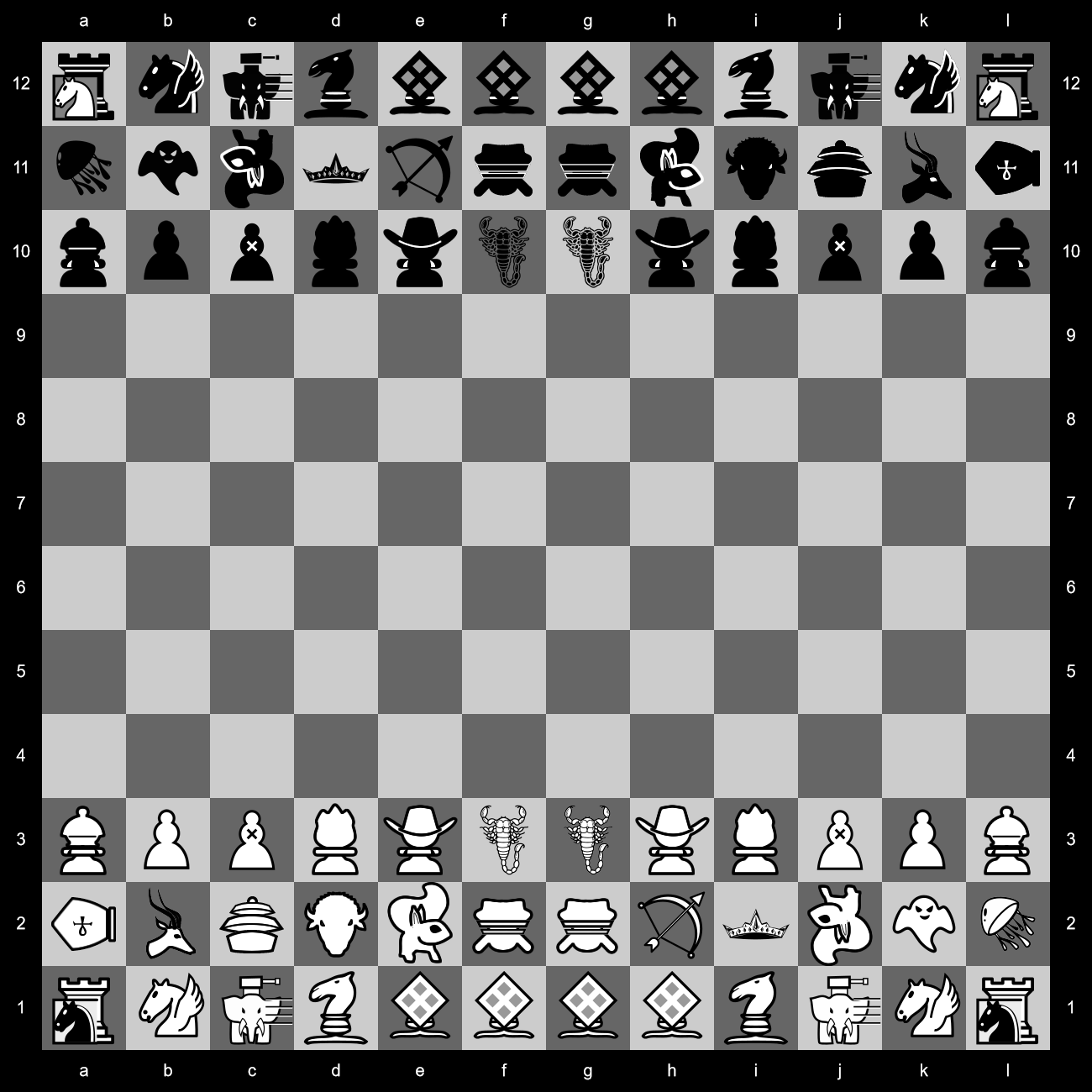
Alternate Setup #1
Another way to manage the second row would be to simply allow the Black player to set up the pieces in any order desired (except that the Bodyguards still go in the two center positions); that order is then duplicated by the White player.
Alternate Setup #2
The players can have two of each of the second-row pieces, and just set up the Hangmen through Displacer Squirrels on both sides of the second row with Bodyguards in the center, and the Archers through Jellyfish on both sides of the third row with standard Knights in the middle; the Pawns would then take the fourth row.
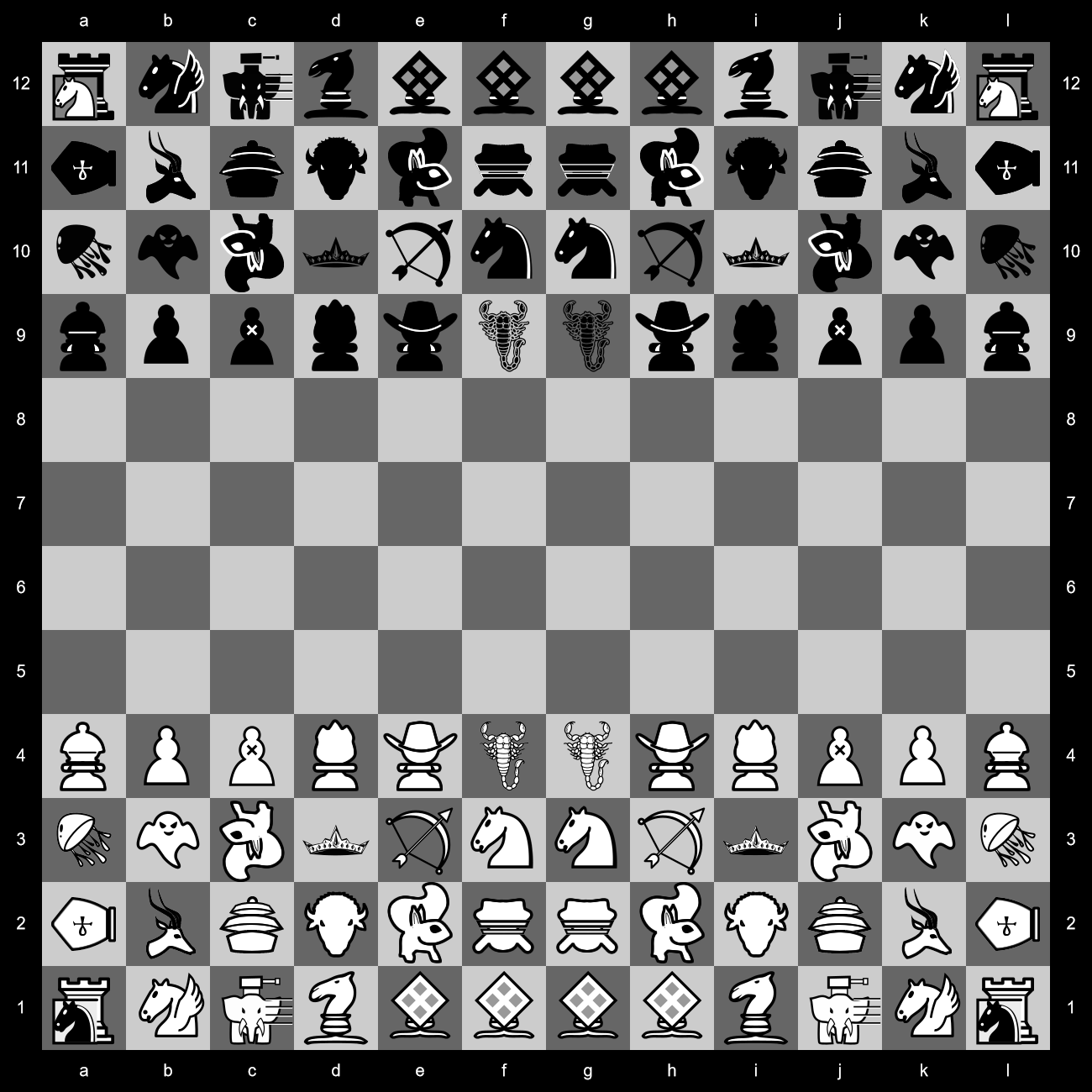
Those Knights could be replaced with Camels, Zebras, Antelopes, Kirins, Phoenixes, or just about any other short- to mid-range mover or leaper.
Pieces
Main Pieces
Archer: Moves two spaces diagonally, or makes "rifle captures" at (1,2).
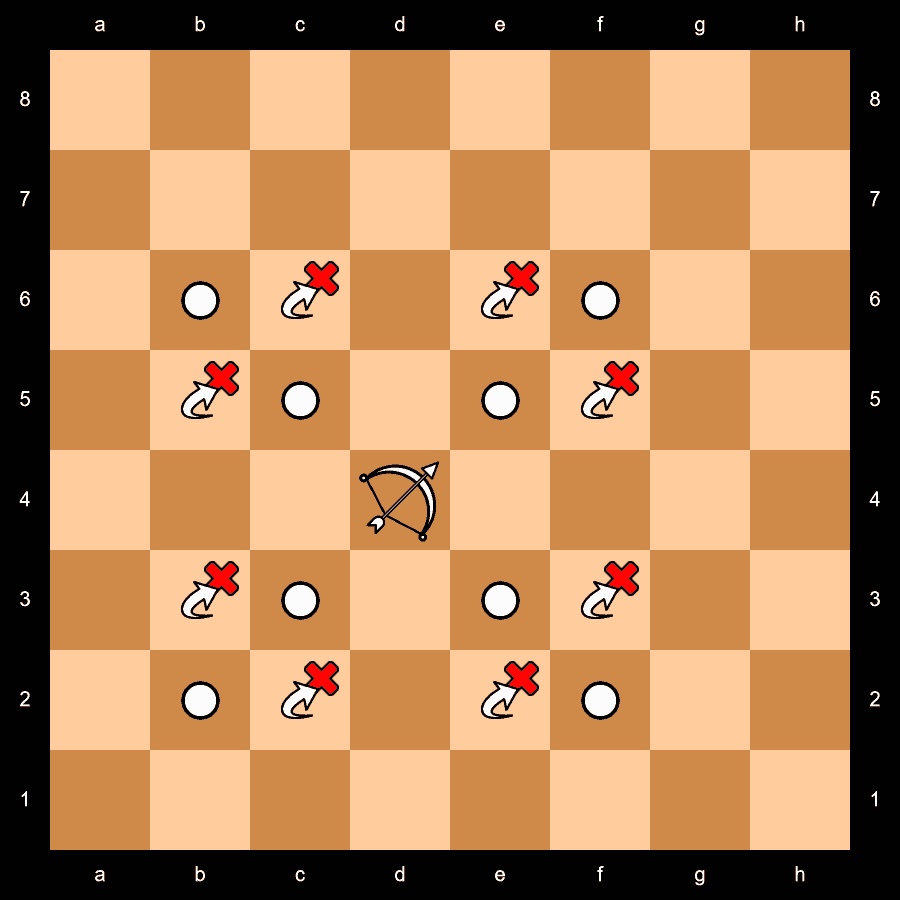
Bodyguard: Moves one or two spaces in any direction. Also has the Hia power: any sliding piece that comes into an adjacent space stops immediately, and can only move one square at a time. (This is discussed in greater detail below.)

Buffalo: Can make a leap of (1,2)(1,3)(2,3).
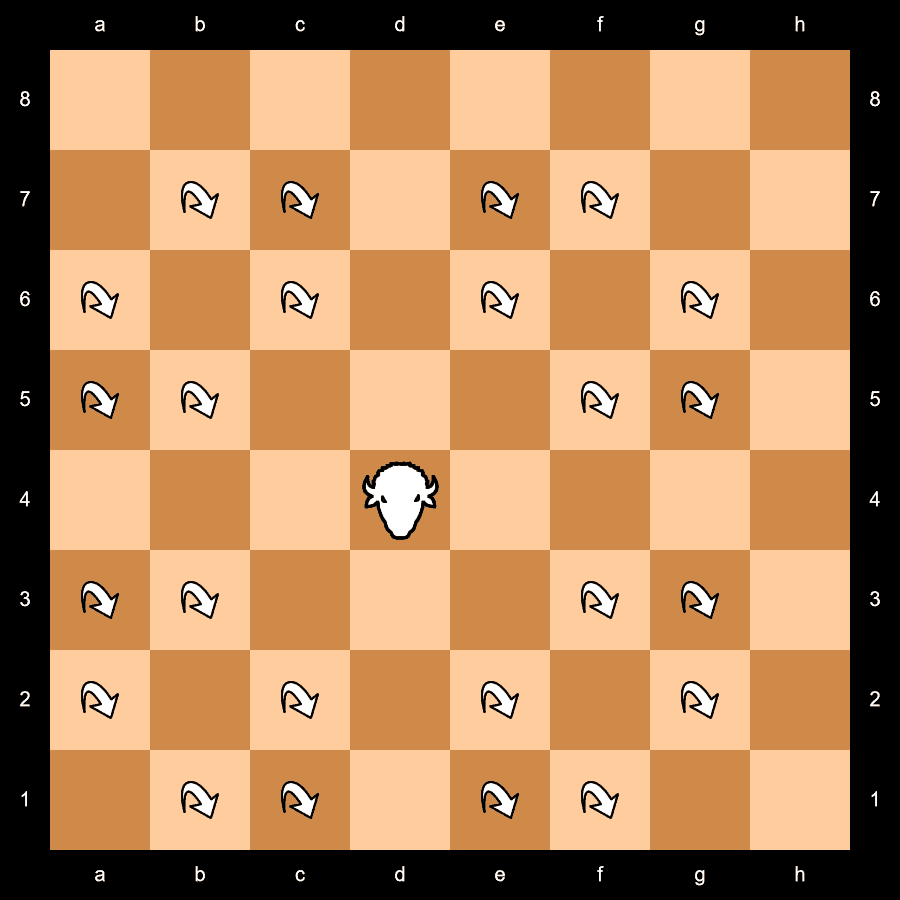
Caliph: Moves diagonally like a Bishop, or leaps (1,3) like a Camel.

Dayrider: Can move to any adjacent space, or make repeated 2-step leaps in any direction. (All leaps must be the same direction.)

Displacer Squirrel: Like a regular Squirrel, the Displacer Squirrel can leap to any space two squares away, including a Knight's move. If there's a friendly piece on that perimeter, the Displacer Squirrel may also switch places with it.
Note that, in this context, "Displacer" refers to the ability to trade places.
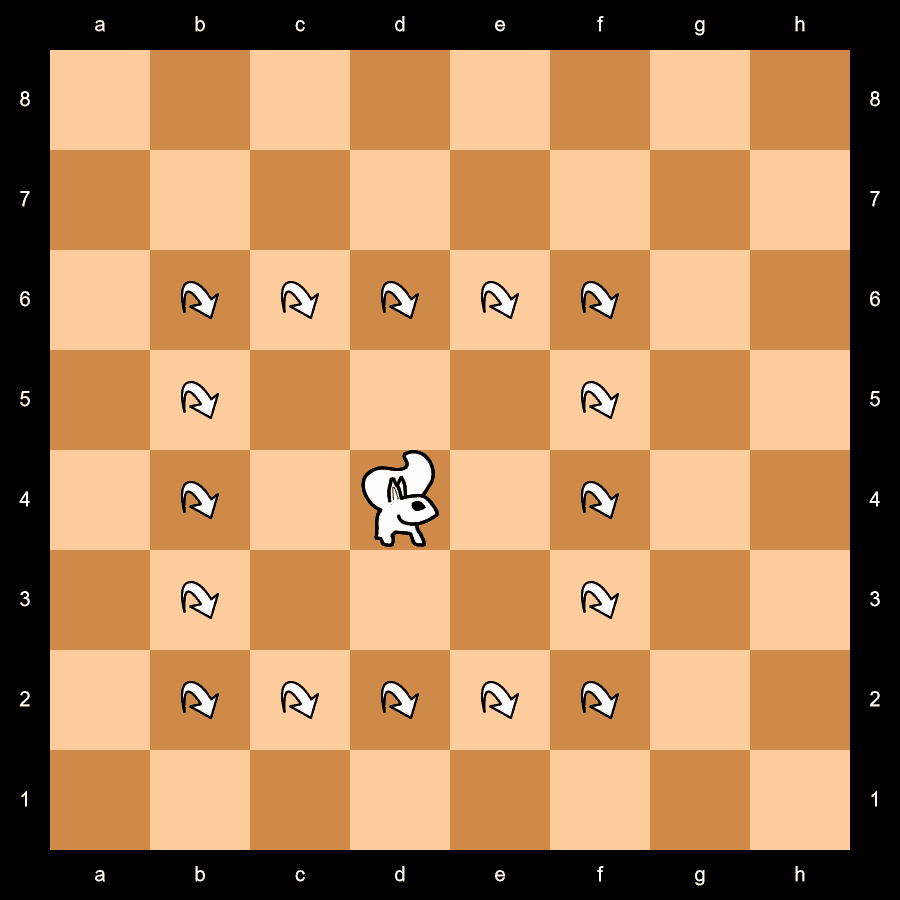
Friend: This is the centerpiece of the game. The Friend has no moves of its own, but "borrows" the move, along with any special powers or properties, of any piece that guards it (see below).
Gerbil: Can leap two spaces diagonally, or (1,4).

Ghost: Moves to any adjacent square, or leaps to any square two spaces away, but cannot capture that way. Rather it captures by "passing through" an adjacent square on its way to the next square beyond (a "locust" capture).

Hangman: Moves one square in any direction. Captures by moving directly away from an enemy piece. (Note that this capture is not mandatory.)

Impala: Can leap (1,2)(3,4).
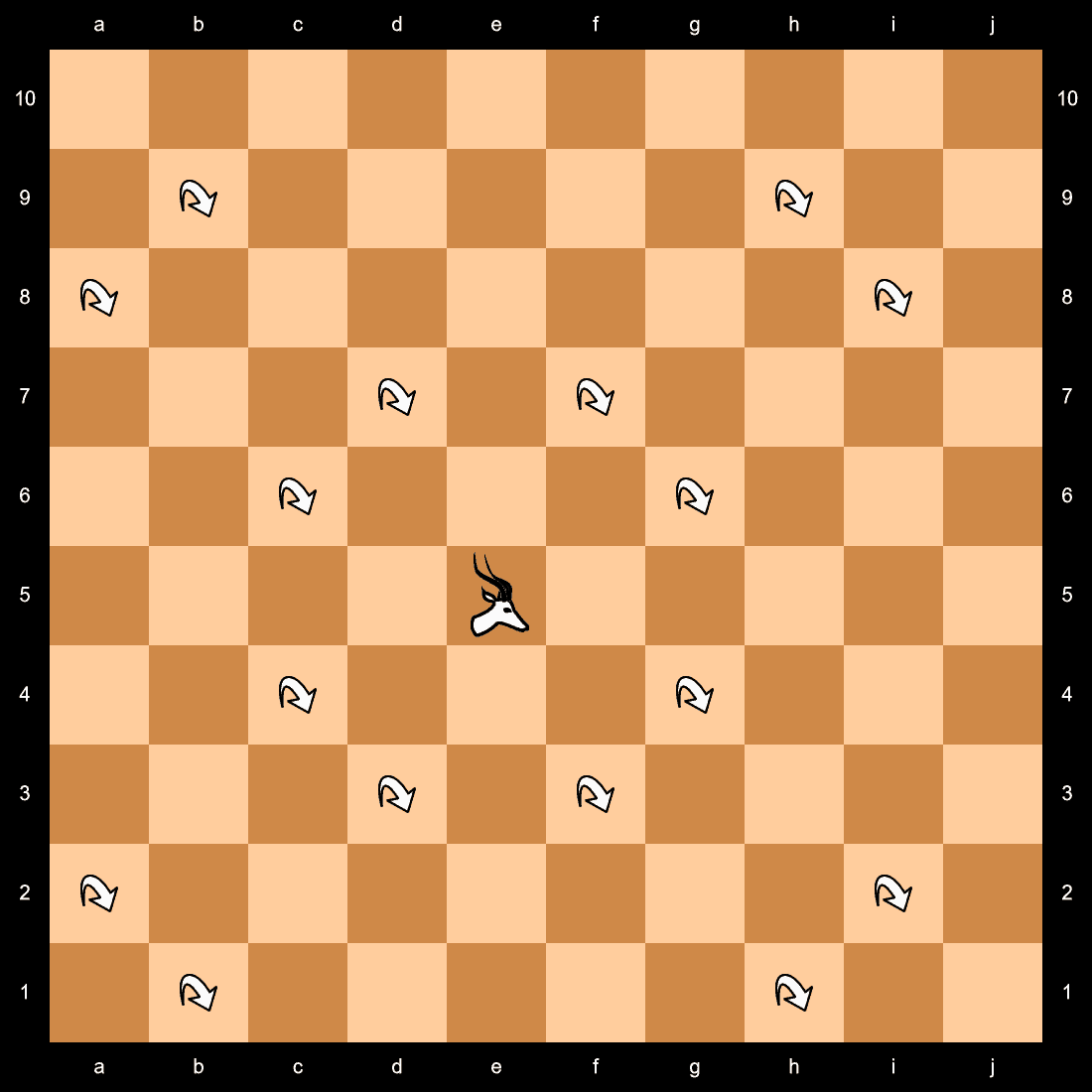
Jellyfish: Moves one square in any direction. Any enemy piece in a neighboring square cannot move. Also, the Jellyfish is poisonous; any piece that captures it (except with a rifle capture) is itself captured.
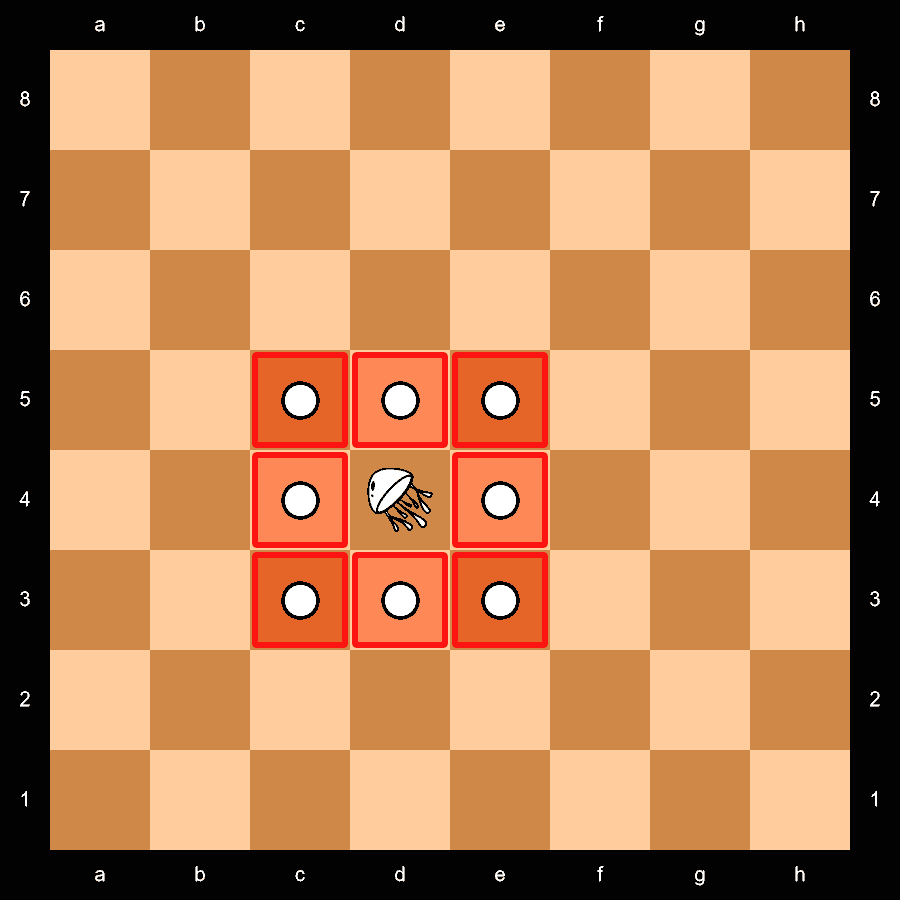
Lady in Waiting: Moves up to 6 squares in any diagonal or orthogonal direction.

Midnighter: Moves repeated steps of (1,2)(2,5)(3,5) in the same direction. (It only uses one of those leaps in any given move.)

Mtawala: Moves orthogonally like a Rook, or (2,3) like a Zebra.

Poison: Moves one square orthogonally to capture, or a "lame Knight" move (1,2) without capturing. Also, any piece that captures it, except with a rifle capture, is also captured, because the poison is, well, poisonous.

Pawns
All Pawns move as the standard Chess pawn, except as noted.
Berolina Pawn: Moves one space diagonally forward without capturing, or captures one space directly forward. Has an opening option of two spaces diagonally forward.

Chicken Pawn: If under attack, can move directly backward like a Rook, or diagonally backward like a Bishop. (Hey, they can't all be brave.)
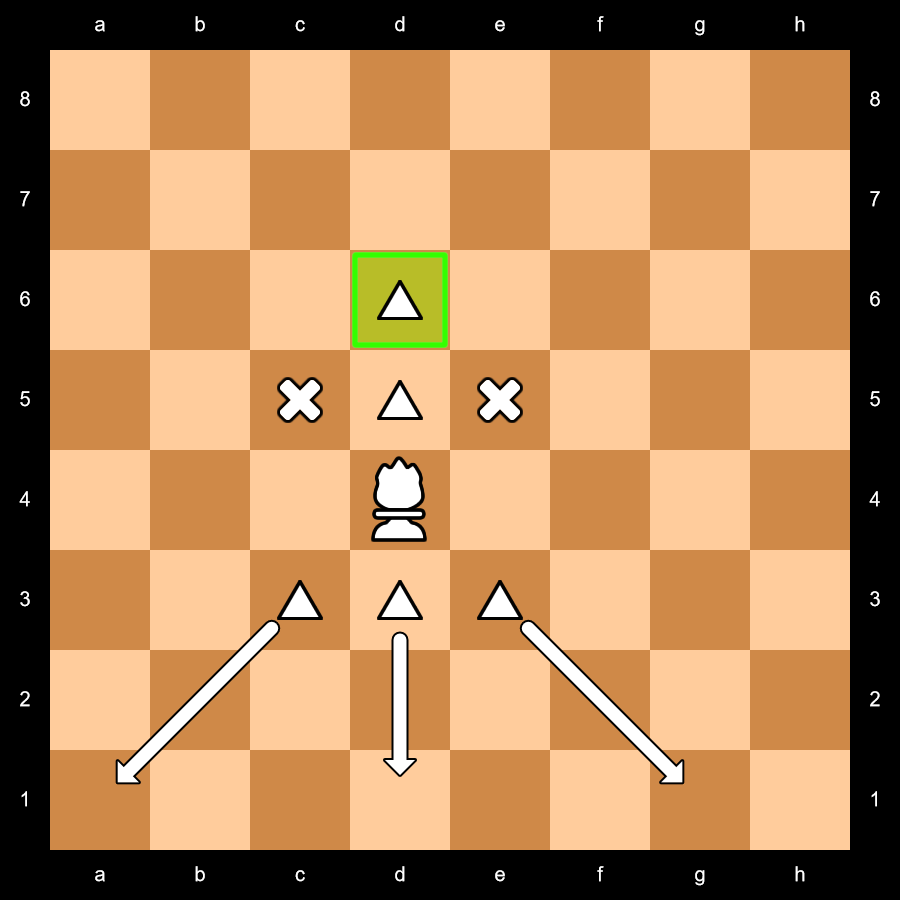
Mecklenbeck Pawn: Promotes on the 10th rank (9th if Alternate Setup #2 is used) instead of the 12th.
Patient Pawn: Has an opening option of two spaces directly forward, or one space directly forward and then capturing one space diagonally forward.
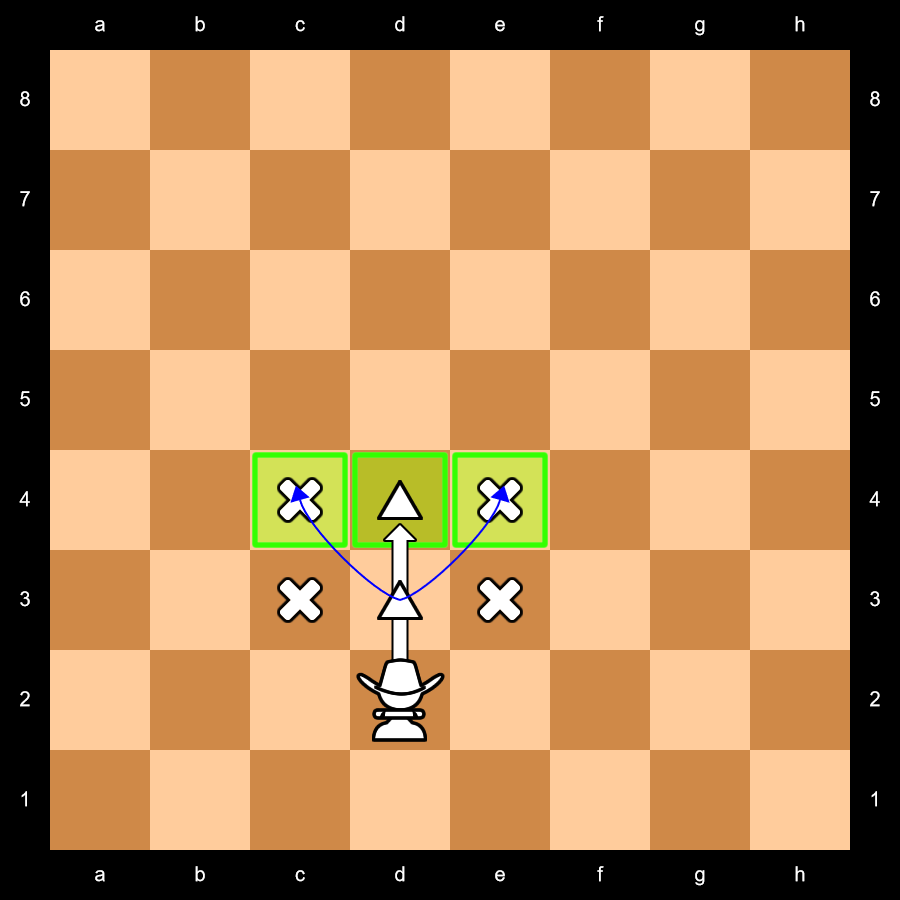
Scorpion Pawn: Can also leap (1,2) wide and forward (that is, one space forward and two to either the left or right) without capturing.

Standard Pawn: Moves one space directly forward without capturing, or captures one space diagonally forward. Has an opening option of two spaces directly forward. (It's not just like the standard Pawn; it is the standard Pawn.)
Rules
Because there is no King, there is also no Castling.
Victory is achieved by capturing all four of the opponent's Friends -- or, technically, when the last Friend is in checkmate. Because there are four Friends, "check" does not have to be declared until there's only one left (though it still would be the polite thing to do).
Pawn promotion is to any piece that's been captured, other than a Friend or another type of Pawn.
Special Abilities
Some of the pieces' special abilities warrant expanded explanation.
Bodyguard: The Bodyguard's "Hia power" is a passive one. Any sliding piece -- Archer, Caliph, Lady in Waiting, or Mtawala, as well as a Friend trying to use their moves, and even an enemy Bodyguard -- in an adjacent square can only move one space. The Archer can still use its rifle capture, and the Caliph and Mtawala can still use their leaps (as can any other leaping piece), but as far as sliding goes they're limited to just one space. This includes not only starting in a space next to the Bodyguard, but also trying to slide past it; any sliding piece is stopped in its tracks as soon as it reaches a square adjacent to the Bodyguard.
A Ghost next to a Bodyguard may use its sliding move to capture the Bodyguard (the capture turns off the Hia power and allows the rest of the move), but not in any other direction.
This power may be turned off for one or more turns, should the player wish. (If a Bodyguard turns off the power while a Friend is borrowing it, that doesn't affect the Friend at all.)
Displacer Squirrel: The Displacer Squirrel can still capture enemy pieces normally, as well as Displace friendly ones.
For purposes of a Pawn's "initial move," Displacement does count as a move.
Friend: As mentioned above, a Friend can receive abilities from any friendly piece that guards it -- that is, it would be able to immediately capture any piece that captures the Friend.
The Friend cannot capture with a non-capturing move, nor move without capture with a capture-only move.
A Friend only gets the special initial moves of a Pawn if neither the Pawn granting the ability nor the Friend has moved yet (meaning it can only be done with the help of another Friend). It does not gain the ability to make en passant capture, or to promote; nor does it get a Rook's or King's ability to castle. (See the Note below.)
Special abilities that the Friend can also receive include the Archer's rifle capture, Bodyguard's Hia power, the Displacer Squirrel's ability to trade places with friendly pieces, the Ghost's locust capture, the Hangman's withdrawing capture, the Jellyfish's immobilizing and poison, and the Poison's poison. (In a sense, the rifle capture, locust capture, and withdrawing capture are special moves rather that "special powers,"
The Poison's and Jellyfish's powers cannot be turned off, so their powers are not optional for the Friend either.
The Displacer Squirrel's and Hangman's powers can only be used with the respective pieces' moves. That is, a Friend with a Displacer Squirrel's ability could only switch places with a friendly piece two spaces away, and a Friend with a with a Hangman's ability could only move one space when doing a withdrawing capture.
A Friend can gain moves and abilities from another Friend. This can cascade to a third Friend -- but isn't necessarily reciprocal. For example, if Friend 1 is gaining the abilities of a Caliph and is using it to guard Friend 2, who is also gaining the abilities of an Archer, Friend 2 also gains the abilities of the Caliph, but Friend 1 doesn't gain the abilities of the Archer because Friend 2 cannot guard it -- if Friend 1 is captured, Friend 2 loses the Caliph's move and so cannot use it to capture Friend 1's attacker.
A simple way to think about that is: if the Friend was an enemy piece, and nothing else on the board changed, could the other piece capture it? If the answer is yes, then the Friend can borrow the piece's abilities.
Jellyfish: Any piece adjacent to a Jellyfish cannot move, including leaps, slides, and rifle captures. However, unlike the case with the Bodyguard, this does not affect pieces merely moving past the Jellyfish.
Notes
With four Friends on each side to deal with, the balance of power can shift wildly during the middle part of any game. Moving just about any piece can add powers to Friends or take them away, on both sides. The pieces with special powers, and Friends who gain those powers, can affect nearly anything on the board.
Normally, the Friend doesn't gain any of a piece's "special moves" (initial double move, en passant capture, castling) at all, and under Mr. Brown's rules presumably wouldn't gain any special abilities from other pieces either, other than those based on movement (like locust, withdrawing, and possibly rifle captures, and Displacing). I've altered that rule for this game; pieces like the Bodyguard, the Jellyfish, and the Poison are here specifically to explore the possibilities.
This is a more-or-less deliberately exaggerated example of a Friend's potential in an actual game. Here, the Friends are not only the pieces to defend, they're also potentially the most powerful attackers in the game. The second row is packed with oddball pieces for just that reason: to show what a Friend is capable of.
 This 'user submitted' page is a collaboration between the posting user and the Chess Variant Pages. Registered contributors to the Chess Variant Pages have the ability to post their own works, subject to review and editing by the Chess Variant Pages Editorial Staff.
This 'user submitted' page is a collaboration between the posting user and the Chess Variant Pages. Registered contributors to the Chess Variant Pages have the ability to post their own works, subject to review and editing by the Chess Variant Pages Editorial Staff.
By Bob Greenwade.
Last revised by Bob Greenwade.
Web page created: 2023-08-13. Web page last updated: 2023-10-22
